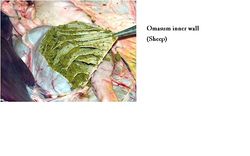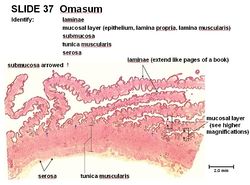Difference between revisions of "Omasum - Anatomy & Physiology"
(→Links) |
Fiorecastro (talk | contribs) |
||
| (14 intermediate revisions by 8 users not shown) | |||
| Line 1: | Line 1: | ||
| + | {{OpenPagesTop}} | ||
==Introduction== | ==Introduction== | ||
| Line 4: | Line 5: | ||
==Structure== | ==Structure== | ||
| − | |||
[[Image:Omasum Anatomy Sheep.jpg|thumb|right|250px|Omasum Anatomy (Sheep) - Copyright RVC 2008]] | [[Image:Omasum Anatomy Sheep.jpg|thumb|right|250px|Omasum Anatomy (Sheep) - Copyright RVC 2008]] | ||
| − | The omasum is right of the midline. The [[Rumen - Anatomy & Physiology|Rumen]] and [[Reticulum - Anatomy & Physiology|reticulum]] are located to the left and the liver and body wall to the right. | + | The omasum is right of the midline. The [[Rumen - Anatomy & Physiology|Rumen]] and [[Reticulum - Anatomy & Physiology|reticulum]] are located to the left and the liver and body wall to the right. The omasum is covered by lesser omentum and is bilaterally flattened. It is located at ribs 8-11. The lower pole has an extensive connection to the fundic region of the [[Abomasum - Anatomy & Physiology|abomasum]]. The '''omasal canal''' is formed between the end of the '''laminae''' and the '''omasal groove''', part of the '''gastric groove''' between the cardia and the pyloric sphincter. The omasal canal passes between the [[Reticulum - Anatomy & Physiology|reticulum]] and the [[Abomasum - Anatomy & Physiology|abomasum]]. Its mucosa is smooth except for particularly large papillae around the reticulo-omasal opening. The omaso-abomasal opening is a large and oval, partly covered by overhanging abomasal folds. |
==Function== | ==Function== | ||
| − | A function of the omasum is absorption. Food enters omasum at second biphasic reticular contraction. | + | A function of the omasum is absorption. Food enters omasum at second biphasic reticular contraction. The omasum itself has biphasic contractions. The first contraction expels fluid by squeezing the ingesta from the omasal canal between the lamellae. The second contraction expels solids by mass contraction of the omasum. Contractions are slower than the rumenoreticular contractions (see [[Rumination|rumination]]). Food is squeezed between lamellae. |
==Vasculature== | ==Vasculature== | ||
| − | The blood supply to the omasum includes the '''cranial mesenteric artery''', | + | The blood supply to the omasum includes the '''cranial mesenteric artery''', the '''left gastric''' and the '''left gastroepiploic arteries'''. |
==Innervation== | ==Innervation== | ||
| − | The omasum is innervated by the '''dorsal vagus nerve''' ([[Cranial Nerves - Anatomy & Physiology|CN X]]) (most important) and the '''ventral vagus nerve''' | + | The omasum is innervated by the '''dorsal vagus nerve''' ([[Cranial Nerves - Anatomy & Physiology|CN X]]) (most important) and the '''ventral vagus nerve'''. |
==Lymphatics== | ==Lymphatics== | ||
| Line 26: | Line 26: | ||
==Histology== | ==Histology== | ||
| − | [[Image:Omasum Histology Sheep.jpg|thumb|right| | + | [[Image:Omasum Histology Sheep.jpg|thumb|right|250px|Omasum Histology (Sheep) - Copyright RVC 2008]] |
| − | + | The omasum has a '''keratinised stratified squamous epithelium'''. It is firm in texture and can vary in size. '''Lamellae''' thrown into leaves divide the lumen into narrow and uniform recesses. It contains no glands. | |
| − | |||
| − | |||
| − | |||
| − | |||
| − | |||
| − | |||
| − | + | The '''papillae''' of the omasum are mostly small and lenticular, although some can be large and [[Tongue - Anatomy & Physiology#Types of Papillae|conical]]. The '''circular tunica muscularis''' extends into papillae of long laminae and the '''lamina muscualris''' extends into papillae encircling the '''tunica muscularis'''. The omasum has 3 smooth muscle layers in the papillae therefore they are very motile. | |
| − | |||
| − | |||
| − | |||
| − | |||
| − | |||
| − | |||
| − | |||
| − | |||
| − | |||
| − | |||
==Species Differences== | ==Species Differences== | ||
===Small Ruminant=== | ===Small Ruminant=== | ||
| − | The small ruminants have a smaller omasum | + | The small ruminants have a smaller omasum, which is bean shaped. |
===Bovine=== | ===Bovine=== | ||
| Line 57: | Line 41: | ||
==Links== | ==Links== | ||
| − | + | '''Click here for information on [[Rumen - Anatomy & Physiology|rumen]]''' | |
| − | |||
| − | '''Click here for information on [[Rumen - Anatomy & Physiology|rumen | ||
| − | |||
| − | |||
| − | |||
| − | |||
| − | |||
| − | |||
| − | |||
| − | |||
| − | |||
| − | |||
| − | [ | + | '''Click here for information on [[Reticulum - Anatomy & Physiology|reticulum]]''' |
| − | [ | + | '''Click here for information on [[Abomasum - Anatomy & Physiology|abomasum]]''' |
| − | |||
| − | [ | + | {{Template:Learning |
| + | |flashcards = [[Omasum Flashcards]] | ||
| + | |videos = [[Video: Bovine omasum potcast|Bovine omasum potcast]]<br>[[Video: Ovine omasum and abomasum potcast|Ovine omasum and abomasum potcast]]<br>[[Video: Sections of the interior of the complex ruminant stomach potcast|Sections of the interior of the complex ruminant stomach potcast]]<br>[[Video: Ruminant forestomach structure dissection|Ruminant forestomach structure dissection]] | ||
| + | |powerpoints = [[Ruminant Gastrointestinal Tract Histology resource|Histology of the ruminant gastrointestinal tract]] | ||
| + | }} | ||
| + | ==Webinars== | ||
| + | <rss max="10" highlight="none">https://www.thewebinarvet.com/gastroenterology-and-nutrition/webinars/feed</rss> | ||
[[Category:Stomach - Anatomy & Physiology]] | [[Category:Stomach - Anatomy & Physiology]] | ||
| − | [[Category: | + | [[Category:A&P Done]] |
| + | [[Category:Alimentary Anatomy - Cattle]] | ||
Latest revision as of 14:46, 25 November 2022
Introduction
The omasum is the third chamber in the ruminant stomach. It lies within the intrathoracic part of the abdomen so cannot be palpated manually. Instead it is examined by ausculation. The omasum has biphasic contractions which squeeze fluid out of the food before allowing the ingesta to continue into the abomasum. Absorption of volatile fatty acids continues in the omasum.
Structure
The omasum is right of the midline. The Rumen and reticulum are located to the left and the liver and body wall to the right. The omasum is covered by lesser omentum and is bilaterally flattened. It is located at ribs 8-11. The lower pole has an extensive connection to the fundic region of the abomasum. The omasal canal is formed between the end of the laminae and the omasal groove, part of the gastric groove between the cardia and the pyloric sphincter. The omasal canal passes between the reticulum and the abomasum. Its mucosa is smooth except for particularly large papillae around the reticulo-omasal opening. The omaso-abomasal opening is a large and oval, partly covered by overhanging abomasal folds.
Function
A function of the omasum is absorption. Food enters omasum at second biphasic reticular contraction. The omasum itself has biphasic contractions. The first contraction expels fluid by squeezing the ingesta from the omasal canal between the lamellae. The second contraction expels solids by mass contraction of the omasum. Contractions are slower than the rumenoreticular contractions (see rumination). Food is squeezed between lamellae.
Vasculature
The blood supply to the omasum includes the cranial mesenteric artery, the left gastric and the left gastroepiploic arteries.
Innervation
The omasum is innervated by the dorsal vagus nerve (CN X) (most important) and the ventral vagus nerve.
Lymphatics
There are numerous small lymph nodes that are scattered in the omasal curvatures. The lymph drains to larger atrial nodes between the cardia and the omasum, then to the cistera chyli.
Histology
The omasum has a keratinised stratified squamous epithelium. It is firm in texture and can vary in size. Lamellae thrown into leaves divide the lumen into narrow and uniform recesses. It contains no glands.
The papillae of the omasum are mostly small and lenticular, although some can be large and conical. The circular tunica muscularis extends into papillae of long laminae and the lamina muscualris extends into papillae encircling the tunica muscularis. The omasum has 3 smooth muscle layers in the papillae therefore they are very motile.
Species Differences
Small Ruminant
The small ruminants have a smaller omasum, which is bean shaped.
Bovine
The lower pole of the omasum contacts the abdominal floor below the costal arch.
Links
Click here for information on rumen
Click here for information on reticulum
Click here for information on abomasum
| Omasum - Anatomy & Physiology Learning Resources | |
|---|---|
 Test your knowledge using flashcard type questions |
Omasum Flashcards |
 Selection of relevant videos |
Bovine omasum potcast Ovine omasum and abomasum potcast Sections of the interior of the complex ruminant stomach potcast Ruminant forestomach structure dissection |
 Selection of relevant PowerPoint tutorials |
Histology of the ruminant gastrointestinal tract |
Webinars
Failed to load RSS feed from https://www.thewebinarvet.com/gastroenterology-and-nutrition/webinars/feed: Error parsing XML for RSS

